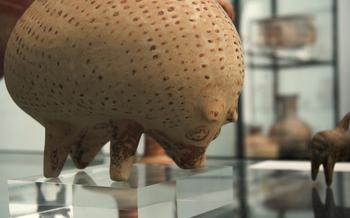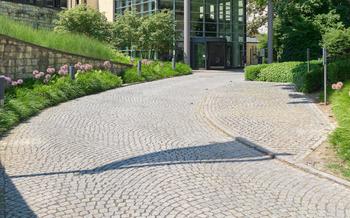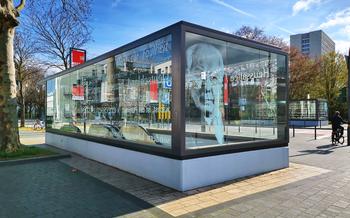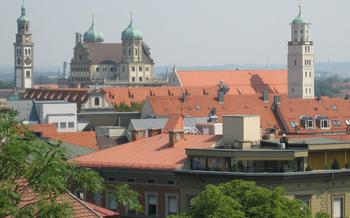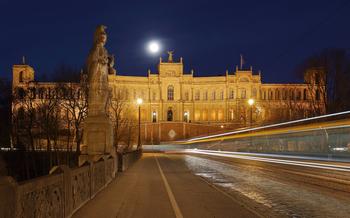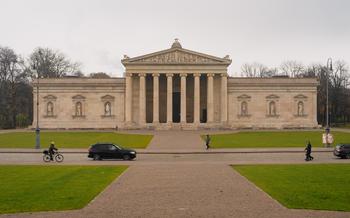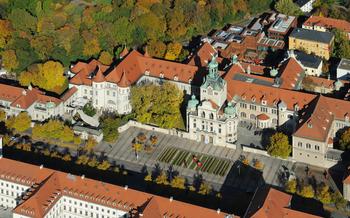
Bavarian State Archaeological Collection
- A Journey Through History
- Unearthing Ancient Civilizations
- Treasures of the Bronze Age
- Celtic Heritage Comes Alive
- Roman Empire's Legacy
- Medieval Masterpieces
- Interactive Experiences
- Discovering Hidden Treasures
- Guided Tours and Workshops
- Educational Programs for Schools
- Accessibility and Visitor Amenities
- Location and Transportation
- Hours of Operation and Admission Fees
- Insider Tip
A Journey Through History
The Bavarian State Archaeological Collection, established in 1855, invites history and archaeology enthusiasts to embark on a captivating journey through the rich cultural heritage of Bavaria. Housed in a majestic building in the heart of Munich, the museum boasts an impressive array of artifacts that narrate the compelling story of human existence in Bavaria from prehistoric times to the Middle Ages. Highlights of the collection include exquisite bronze artifacts that showcase the masterful craftsmanship of the Bronze Age, intricate Celtic jewelry and weapons that provide a glimpse into the enigmatic world of the Celts, and Roman relics that testify to the enduring legacy of the Roman Empire. Each artifact bears witness to the ingenuity, artistry, and cultural achievements of ancient civilizations, offering visitors a profound understanding of our shared past.
Unearthing Ancient Civilizations
The Bavarian State Archaeological Collection boasts a remarkable array of artifacts, taking visitors on a captivating journey through human history. From the humble beginnings of the Stone Age to the grandeur of the Middle Ages, each exhibit tells a story of cultural evolution and the remarkable ingenuity of our ancestors.
Stone Age tools, crafted with precision and purpose, offer a glimpse into the lives of early humans. Their ability to adapt and thrive in a challenging environment is evident in the finely crafted spearheads, scrapers, and axes on display. Moving forward in time, the Bronze Age exhibits showcase the mastery of metalworking techniques. Exquisite bronze ornaments, weapons, and tools reveal the sophistication and artistry of ancient civilizations.
Interactive displays and educational resources enhance the visitor experience, providing insights into archaeological methods and the significance of the artifacts. Explore replicas of ancient dwellings, handle replicas of tools, and engage with interactive exhibits that bring history to life. The Bavarian State Archaeological Collection is not just a repository of artifacts; it is a vibrant space where the past comes alive, inspiring curiosity and a deeper appreciation for our shared human heritage.
Treasures of the Bronze Age
Among the most captivating exhibits at the Bavarian State Archaeological Collection are the exquisite bronze artifacts that provide a glimpse into the advanced metalworking techniques of the Bronze Age. These finely crafted objects, dating back to 2200-800 BC, showcase the remarkable artistry and technical prowess of ancient civilizations.
The collection boasts an array of bronze weapons, tools, and ornamental pieces, each intricately designed and meticulously crafted. Visitors can marvel at the intricate details of swords, daggers, and axes, as well as the functionality and beauty of bronze vessels, jewelry, and figurines.
These artifacts offer a tangible connection to the lives and customs of Bronze Age communities. They shed light on the development of metallurgy, trade networks, and cultural exchange during this transformative period in human history. Moreover, they provide insights into the symbolism and beliefs of ancient societies, as many of these objects were imbued with religious or ceremonial significance.
The Bavarian State Archaeological Collection's Bronze Age treasures are a testament to the ingenuity and creativity of our ancestors. They stand as a reminder of the rich cultural heritage and technological advancements that shaped the course of human civilization.
Celtic Heritage Comes Alive
The Bavarian State Archaeological Collection boasts an impressive array of Celtic artifacts, providing a glimpse into the vibrant culture of these ancient people. Exquisite jewelry, intricately designed weapons, and tools offer insights into their craftsmanship and daily lives. Visitors can admire the intricate patterns and symbols adorning Celtic jewelry, including necklaces, bracelets, and brooches. These adornments often held both aesthetic and symbolic significance, representing status, wealth, or protection.
Weaponry such as swords, spears, and shields showcases the Celts' prowess in battle. The intricate metalwork and craftsmanship of these weapons highlight the Celts' mastery of metallurgy. Tools like sickles, axes, and querns provide a glimpse into their agricultural practices and domestic life.
The collection also features remnants of Celtic settlements, including pottery, household items, and religious artifacts. These remains offer insights into their social structure, economy, and spiritual beliefs. Interactive displays and educational resources further enhance the visitor experience, allowing them to delve deeper into the fascinating world of the Celts.
Roman Empire's Legacy
The Bavarian State Archaeological Collection houses a wealth of artifacts from the Roman period, shedding light on the Roman occupation of Bavaria and its profound impact on the region. Among the highlights are intricate pottery, glassware, and metalwork, showcasing the Romans' advanced craftsmanship. Visitors can marvel at the remains of Roman settlements, including foundations of buildings, roads, and aqueducts, providing a glimpse into the daily lives of the Roman inhabitants. Statues, coins, and inscriptions further enhance our understanding of Roman culture and administration in Bavaria. Exploring these Roman artifacts offers a fascinating journey through a significant chapter in Bavarian history, revealing the enduring legacy of the Roman Empire.
Medieval Masterpieces
A journey through the Middle Ages unfolds at the Bavarian State Archaeological Collection, showcasing exquisite sculptures, paintings, and tapestries that transport visitors to a bygone era. These medieval masterpieces provide a glimpse into the artistic and cultural achievements of the period.
Intricate carvings adorn stone sculptures, depicting religious figures, mythical creatures, and scenes from everyday life. The artistry and attention to detail are breathtaking, showcasing the skill and dedication of medieval craftsmen.
Paintings on wood and canvas come alive with vibrant colors and expressive brushstrokes, capturing the essence of the era. From religious iconography to portraits of royalty, these works of art offer a visual narrative of medieval life.
Tapestries, woven with intricate threads and dyes, depict historical events, biblical stories, and allegorical scenes. These textile masterpieces tell tales of chivalry, love, and faith.
The influence of Christianity is deeply embedded in medieval art, as evidenced by the numerous depictions of saints, angels, and biblical figures. These works of art served not only as religious artifacts but also as a means of educating and inspiring the faithful.
Exploring the medieval collection at the Bavarian State Archaeological Collection is a journey back in time, offering visitors a profound appreciation for the artistic heritage and cultural significance of this remarkable era.
Interactive Experiences
The Bavarian State Archaeological Collection is not just a repository of ancient artifacts; it's also a place where history comes alive through interactive and engaging exhibits. Visitors of all ages can immerse themselves in the world of archaeology and gain hands-on experience with ancient tools, materials, and technologies.
At the museum's interactive stations, you can try your hand at flint knapping, creating pottery using ancient techniques, or even dressing up in historical costumes. These hands-on activities provide a deeper understanding of the skills and craftsmanship of our ancestors.
For a more immersive experience, join one of the museum's guided tours. Led by knowledgeable archaeologists, these tours offer a behind-the-scenes look at the museum's collection and provide insights into the latest archaeological research.
The Bavarian State Archaeological Collection also hosts educational workshops for families and school groups. These workshops offer a variety of hands-on activities, such as making replicas of ancient artifacts, exploring archaeological sites, and learning about different cultures and civilizations.
Through its interactive exhibits, guided tours, and educational workshops, the Bavarian State Archaeological Collection offers a unique and engaging way to learn about the rich history and diverse cultures of Bavaria and beyond.
Discovering Hidden Treasures
Venturing beyond the main exhibition halls, visitors can delve into the hidden treasures housed within the museum's storage facilities. Here, under the watchful eyes of curators and conservators, lie artifacts that have yet to see the light of day. These storerooms offer a glimpse into the immense wealth of the collection, with countless objects waiting to be studied, cataloged, and eventually displayed.
The museum's curators are the gatekeepers of these hidden treasures, meticulously documenting and researching each artifact. Their work involves not only preserving the collection but also uncovering the stories behind the objects. Visitors may have the opportunity to witness firsthand the curators' meticulous examination of artifacts, gaining insights into the scientific processes that bring history to life.
Behind-the-scenes tours of the storage facilities provide a unique opportunity to learn about the challenges of preserving and managing a collection of this magnitude. Visitors can discover how artifacts are cleaned, cataloged, and stored, ensuring their longevity for future generations. These tours offer a fascinating glimpse into the unseen world of archaeological research and the dedication of the museum's staff.
Guided Tours and Workshops
Enrich your visit to the Bavarian State Archaeological Collection by joining one of the guided tours led by knowledgeable experts. These tours provide an in-depth look into the museum's highlights and offer fascinating insights into the history and significance of the artifacts. Whether you're a history buff or simply curious about the past, these tours are a great way to gain a deeper understanding of the collection.
The museum also offers a variety of workshops that allow visitors of all ages to engage with archaeology in a hands-on way. These workshops cover a range of topics, from ancient crafts and techniques to the latest archaeological research methods. Whether you're interested in learning how to make a Stone Age tool or trying your hand at pottery, there's a workshop that's perfect for you.
By participating in a guided tour or workshop, you'll not only gain a deeper understanding of the Bavarian State Archaeological Collection but also experience the thrill of archaeological discovery firsthand. Make sure to check the museum's website or inquire at the information desk for the current schedule of tours and workshops.
Educational Programs for Schools
The Bavarian State Archaeological Collection offers a range of educational programs tailored to students of all ages. These programs aim to foster a love for learning and exploration while providing students with a deeper understanding of Bavarian history and archaeology.
School groups can participate in guided tours that are designed to engage students with the museum's collection. These tours are led by experienced educators who bring the past to life through interactive storytelling and hands-on activities. Students can examine artifacts up close, learn about archaeological methods, and gain insights into the lives of people who lived in Bavaria throughout the ages.
The museum also offers workshops and educational programs that allow students to experience archaeology firsthand. They can participate in simulations, conduct mock excavations, and learn about the latest archaeological discoveries. These programs provide students with a unique opportunity to develop critical thinking skills, problem-solving abilities, and a deeper appreciation for the importance of preserving our cultural heritage.
By participating in the educational programs offered by the Bavarian State Archaeological Collection, students can gain a deeper understanding of the past and develop a lifelong passion for learning and exploration.
Accessibility and Visitor Amenities
The Bavarian State Archaeological Collection is committed to providing an inclusive and welcoming environment for all visitors. It features a range of accessibility features to ensure that everyone can fully enjoy the museum's exhibits and programs.
Wheelchair users and visitors with limited mobility can easily navigate the museum's spacious galleries and public areas. All floors are accessible via elevators, and ramps have been installed to eliminate any barriers.
To assist visitors with hearing impairments, the museum offers assistive listening devices that can be used during guided tours and presentations. For those who are visually impaired, tactile exhibits and descriptive audio guides are available to enhance their museum experience.
Families with young children will find a dedicated play area within the museum, where little ones can engage in hands-on activities and imaginative play while learning about archaeology.
To ensure a comfortable visit for all, the museum provides a range of visitor amenities, including a café serving light refreshments and snacks, a well-stocked gift shop where visitors can purchase souvenirs and educational resources, and a cloakroom where they can store their belongings.
Location and Transportation
The Bavarian State Archaeological Collection enjoys a prime location in the vibrant city of Munich, making it easily accessible to visitors. Situated in the heart of the city, the museum is surrounded by other cultural attractions, inviting you to explore the rich heritage of Munich.
Reaching the museum is a breeze with the city's excellent public transportation system. Hop on the U-Bahn (subway) and alight at the Lehel station, which is just a short walk from the museum's doorstep. Alternatively, if you prefer a more scenic journey, take a tram ride along the scenic Isar River and disembark at the Deutsches Museum stop, followed by a leisurely stroll to the museum.
For those arriving by car, there are several parking garages nearby, ensuring a hassle-free visit. The Parkhaus am Deutschen Museum, located adjacent to the museum, offers convenient parking options.
No matter how you choose to travel, the Bavarian State Archaeological Collection is easily accessible, inviting you to delve into the captivating world of archaeology and history.
Hours of Operation and Admission Fees
The Bavarian State Archaeological Collection is open to visitors from Tuesday to Sunday, with varying hours of operation. On Tuesdays, Thursdays, and Fridays, the museum is open from 10 am to 5 pm; on Wednesdays, it extends its hours until 7 pm to accommodate evening visitors. On Saturdays, Sundays, and holidays, the museum opens its doors from 10 am to 6 pm.
Admission fees are reasonable, with adults paying a standard fee for entry. Children and young people under the age of 18, as well as students and seniors, are eligible for discounted rates. It's worth noting that admission is free on the first Sunday of every month, making it an excellent opportunity for budget-conscious travelers or families to explore the museum's treasures.
To enhance your visit, consider joining a guided tour, which is offered in both German and English. Tours are available at an additional cost and provide a deeper dive into the museum's collection and the fascinating stories behind the artifacts.
Before your visit, check the museum's website for the most up-to-date information on hours of operation, admission fees, and guided tour schedules. It's always a good idea to plan ahead and arrive early to avoid crowds, especially during peak tourist season.
Insider Tip
A hidden gem within the Bavarian State Archaeological Collection is the 'Secret Chamber', located in the basement of the museum. Here, visitors can view a selection of artifacts that are not on display in the main exhibition, including rare and unique pieces from various archaeological excavations. The Secret Chamber offers a glimpse into the lesser-known treasures of the museum's collection and provides visitors with an opportunity to learn about the behind-the-scenes work of curators and archaeologists.
For a unique photo spot, head to the 'Bronze Age Gallery' and capture the stunning bronze figurines and weapons that are displayed there. The intricate details and craftsmanship of these artifacts make for beautiful and eye-catching photographs. Alternatively, explore the 'Medieval Art Gallery' and find a quiet corner to photograph the exquisite sculptures and paintings that adorn the walls. The soft, natural light that filters through the stained-glass windows creates a magical atmosphere, perfect for capturing the essence of these medieval masterpieces.
